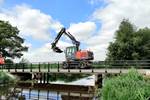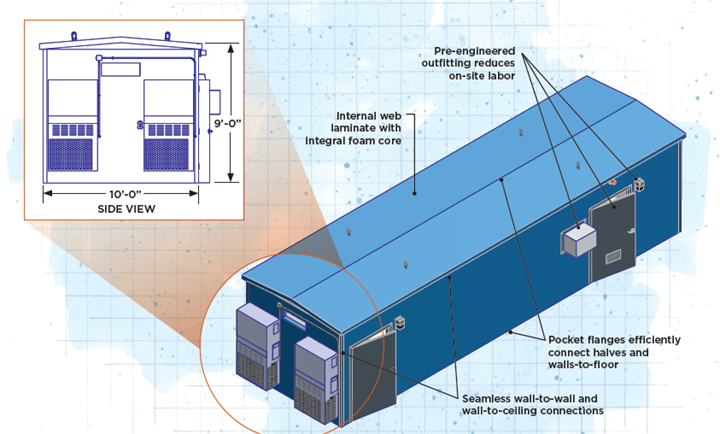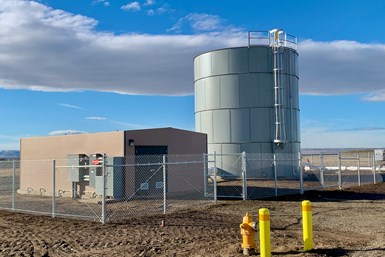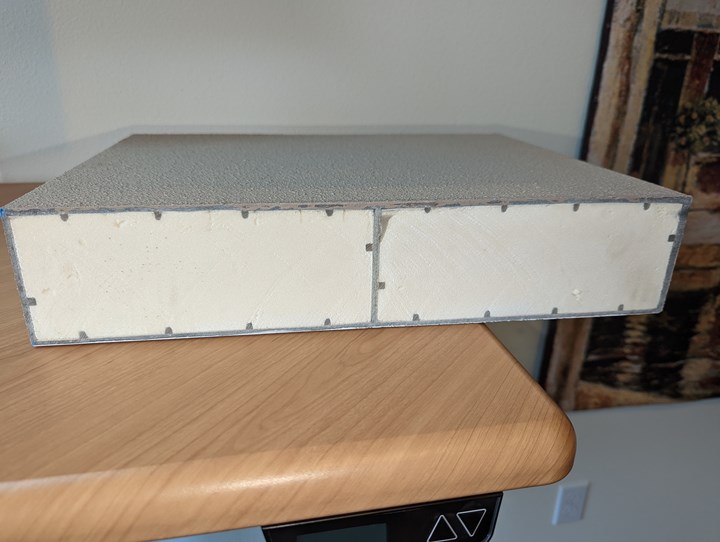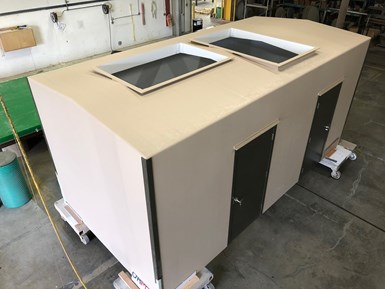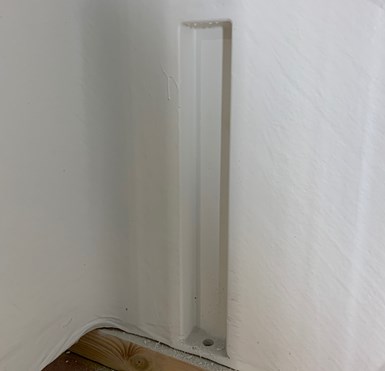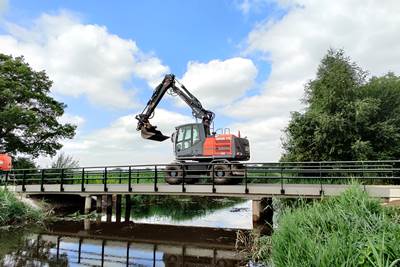Over four decades, Orenco Systems (Sutherlin, Ore., U.S.) has built a solid reputation in wastewater collection and treatment, including the water-tight glass fiber-reinforced polymer (GFRP) tanks that the company’s composites division manufactures. Included in the company’s tank portfolio are rectangular units, open on top with the four sides and bottom fabricated in one piece. With Orenco Composites’ (Roseburg) proven track record of engineering and fabricating these large, seamless structures, it is only natural that the company would regularly seek new applications for the technology. One such market opened up when Orenco realized the value of flipping the tank over. The result is a one-piece unit able to serve as a shelter for valuable equipment, such as the controls of a wastewater lift station (where wastewater is pumped to higher elevation).
“A lift station control room is just an upside-down tank,” Darren Simmie, Orenco Composites sales manager, explains. “We realized we could make high-quality prefab buildings to protect equipment in the field.”
Orenco’s building technology has been installed now in numerous applications similar to the lift station — protecting equipment, electronics and chemicals located in a customer’s on-site outbuildings as well as at remote stations. “It’s the kind of structure that people might drive by and not really take notice,” Andy Bridge, Orenco Composites director of business development, says. But the performance characteristics of the one-piece composite structures for such applications are noteworthy, making them a robust, cost-effective choice to meet the demands placed on these buildings.
Remote cost-efficiency. Lightweight and constructed in one or two pieces, DuraFiber buildings are easily transported to remote sites and installed with minimal labor. Monocoque fabrication results in long service life. Photo Credit, all images: Orenco Composites
“Many of our customers are utilities who tell us, ‘I’m going to use this in my infrastructure for 25 or 30 years,’” Simmie says, adding that these customers want the structure to be not only long lasting but also low maintenance.
Orenco now has a portfolio of one- and two-piece buildings it designs and fabricates under the DuraFiber trademark. The company’s core competency of vacuum-bagged and closed-molded vacuum infusion enables a design-for-manufacture approach that delivers the key performance benefits of these structures: durability, low labor/maintenance requirements and reliable protection from the elements. The GFRP/foam core design also makes the buildings lightweight and strong enough to be transported via truck, rail, cargo container or aircraft.
Monocoque durability
“Monocoque” is a label historically applied to mobile structures — an aircraft fuselage, for example, or a race car chassis. Still, the term seems appropriate for DuraFiber buildings, which are manufactured in a single piece (two pieces for larger structures to accommodate transportation restrictions). The design employs an internal web laminate structure and integral foam core, a combination that creates the building’s freestanding walls and roof. The one-piece design also results in seamless connections between walls and roof — an advantageous feature for buildings subject to the elements and sometimes left unattended for long periods.
Internal web structure. The building’s lightweight composite design achieves needed structural strength and stiffness by including integral web elements.
Alternatives to the DuraFiber design include traditional wood-frame structures and those constructed from cinder block or concrete, as well as an existing GFRP design constructed from a set of flat panels that are sprayed up using chopped fiber reinforcement. “The panels are nice for shipping,” Bridge acknowledges. “They pack flat. But assembly is complicated, and they are not as good structurally. The joints are not watertight, so they rely on bolts and gaskets to keep from leaking. You tend to chase that leaking for the life of that structure.”
In addition to eliminating joints that are vulnerable to water intrusion, the DuraFiber design is also able to support control devices and other equipment attached to its walls. “The way we are doing our laminate structure — web-stiffened — can support any device directly on the wall,” Simmie says. By comparison, panelized GFRP structures require additional support for such equipment, which typically entails embedding wood into the structure. Anytime wood is introduced, so too are the moisture intrusion vulnerabilities of that material, as well as maintenance requirements for painting and sealing.
Preforming and infusion
The inherent physical integrity of a one-piece design contributes to the building’s overall strength and stiffness, and additional design features help optimize structural performance. “We focus on using multiaxial continuous fiberglass, woven or stitched, for additional stiffness,” Bridge illustrates. The design incorporates two fabric weights of VectorFusion stitched multiaxial fabric, produced by VectorPly (Phenix City, Ala., U.S.), to create the desired performance characteristics in different parts of the structure. Other suppliers provide chopped strand mat and veils used in the structure.
Foam core from Atlas (Atlanta, Ga., U.S.) also contributes to the structure’s stiffness. Orenco uses polyurethane and polyisocyanurate foam with a minimum density of 32 kilograms per cubic meter. “Three inches of foam with the internal webs provides plenty of stiffness for the structure,” Simmie notes, “but sometimes we use a greater thickness to increase insulation values up to R-32.”
“Our buildings are engineered to endure hurricanes!” Bridge continues. The buildings are constructed to achieve a wind rating of 258 kilometers per hour (160 miles per hour). “It’s a very robust structure,” he adds. “That’s difficult to do with panel structures.”
Finished buildings in the current Orenco portfolio range in size from 1.2 x 1.2 x 2.4 meters (width by length by height) to 12.2 x 15.2 x 3.7 meters. The buildings’ roofs are rated for a live load of 488 kilograms per square meter (100 pounds per square foot).
Manufacture of the buildings begins with automated cutting of the glass fabric and foam into preforms, using a Rosenthal (Northbrook, Ill., U.S.) sheeter. Foam core pieces are prewrapped with stitched multi-axial fabric, including the web pieces, which consist of fabric-wrapped foam planks. Operators hand lay the dry glass fiber reinforcement preforms that make up the outside of the structure into a steel mold, which is oriented upside-down relative to the finished building. They then position the web and foam core pieces and lastly lay up the preforms for the inside of the structure.
Customized openings. During layup, inserts are included to create openings for doors, windows and vents. Frames are attached post cure using fasteners and adhesives.
Of course, one notable difference between a water treatment tank and an outbuilding is the need for doors, and in some cases, windows or roof and wall vents. Orenco places inserts in the mold prior to layup to create the openings for these features.
Isophthalic polyester (PE) resins from Ineos Group (Fort Worth, Texas, U.S.) are then vacuum infused into the structure. Orenco’s vacuum infusion process ensures integral bonding of the foam core with the GFRP laminates. Cure is typically conducted at room temperature for 24 hours (five hours in the mold), although elevated cure is sometimes used to accelerate cure. Composite laminate skins and webs in the cured structure range between 2 and 5 millimeters thick and have a fiber volume of 60-65%.
Internal walls/ceiling of the cured structure are coated with a polyester gelcoat, typically a bright white to reflect light well, improving visibility. External walls/roof are coated with a high-performance acrylic/urethane copolymer that provides superior weathering resistance, including UV protection, in a low-maintenance material. Both coating materials are supplied by Tuff Coat (Rockaway, N.J., U.S.).
Framing for doors, windows, and roof and wall vents is installed post cure. Frames are manufactured from pultruded GFRP and are attached using mechanical fasteners as well as methyl methacrylate adhesive and urethane acrylate from Scott Bader Co. Ltd. (Wellingborough, U.K.). The doors themselves are designed and constructed from foam and GFRP, similar to the rest of the structure.
Minimal on-site labor
A big cost-saving feature of DuraFiber buildings is their minimal demand for on-site labor during installation and for ongoing maintenance. “We are making a one-piece building,” Bridge emphasizes. “All other applications require on-site building or panelized construction.” He characterizes DuraFiber installation as a “set it and forget it” operation.
“Being pre-engineered is powerful,” Simmie adds. “We’re designing the building, locksets, power load panels, HVAC, etc. The site engineer gets a complete package. It arrives at the job site with minimal labor requirements.” Simmie reports that the larger two-piece building is typically installed on a pre-poured concrete slab using one to two days of on-site labor, while a traditional block construction would require six to eight weeks for the structure, and a total of six to nine months for the fully outfitted building.
High-speed installation. DuraFiber buildings are laid up, cured and outfitted with electrical panel boards, load centers and transformers, plus a variety of HVAC equipment, so that on-site installation labor and time are minimized.
A critical feature of the DuraFiber design that enhances constructability, cost efficiency and maintainability is its internal pocket attachment system. To attach the building to the concrete slab floor, Simmie explains, an inside flange would take up floor space and be more difficult to seal. The pocket flange provides a more secure seal and is contained within the wall structure. For the two-piece buildings, a pocket flange also joins the upper beam and the walls of the two pieces, which are bonded and bolted together. The pocket flanges also offer relatively easy installation compared to other attachment types.
Protection from the elements
The durability and low maintenance of DuraFiber buildings speak to the longevity of the structure — but the level of protection they provide for stored materials and installed equipment is equally, if not more beneficial, from a customer perspective. Certainly an important factor in this protection is the leakproof performance provided by the monocoque design and enhanced by the inherent corrosion resistance of GFRP and the coating materials.
Pocket attachment. DuraFiber buildings use a set of internal pockets flanges to attach the building to the foundation, minimizing attachment space requirements and easing installation.
Also significant is the thermal performance of the structure. This was Bridge’s first thought when asked how DuraFiber buildings advance the state of the art. He replied, “Don’t underestimate the R value. There really is no simple way to use a thermally conductive building material at many of these locations. They need to be highly efficient, using a very small amount of energy. Think of these buildings like a giant Yeti cooler with no conductive paths.” DuraFiber walls and ceilings offer an insulation value of RSI-2.1 to RSI-5.6 (R-18 to R-32), depending on thickness.
DuraFiber’s excellent insulation properties are valuable both for the energy savings and for long-term building code compliance — Simmie points out that building energy codes have gotten more and more strict over time, a trend he expects to continue.
Promising present and future applications
Orenco’s initial building application, which protects lift station controls, has quickly expanded. Today, DuraFiber buildings are protecting materials and equipment in:
- Chlorination and dechlorination
- Motor control centers
- Power distribution centers
- Process and monitoring equipment
- Communication equipment
- Generator housing and sound attenuation
- Chemical feed and storage
Bridge also reports some interest in DuraFiber backyard buildings, not as living quarters (they include no plumbing) but for home offices and similar uses. This application may be realized in the near term. Additionally, Orenco is exploring DuraFiber application to 5G mini data centers. “Fire code requirements are pretty tough,” Bridge acknowledges, so this application would take more time to develop. Orenco would first have to navigate both R&D and regulatory hurdles.
The market for durable, weather-proof, low-maintenance outbuildings should continue to grow at a healthy clip. The need to protect remote materials and equipment has been a part of many types of businesses for a long time, and the types of applications and number of business customers for outbuildings should expand as remote monitoring and control technologies mature and proliferate. Additionally, the cultural shift induced by the pandemic has multiplied the businesses and individuals now familiar and comfortable with working in one location on operations that are occurring in another. Both of these factors should escalate outbuilding market growth.
DuraFiber buildings stand out in this marketplace for their unique set of features and performance characteristics. Orenco’s long history with GFRP design and manufacture, catalyzed by a creativity that literally flipped its existing products upside-down, should position them as a market leader for some time to come.
Related Content
The potential for thermoplastic composite nacelles
Collins Aerospace draws on global team, decades of experience to demonstrate large, curved AFP and welded structures for the next generation of aircraft.
Read MoreCarbon fiber, bionic design achieve peak performance in race-ready production vehicle
Porsche worked with Action Composites to design and manufacture an innovative carbon fiber safety cage option to lightweight one of its series race vehicles, built in a one-shot compression molding process.
Read MorePlant tour: Joby Aviation, Marina, Calif., U.S.
As the advanced air mobility market begins to take shape, market leader Joby Aviation works to industrialize composites manufacturing for its first-generation, composites-intensive, all-electric air taxi.
Read MorePEEK vs. PEKK vs. PAEK and continuous compression molding
Suppliers of thermoplastics and carbon fiber chime in regarding PEEK vs. PEKK, and now PAEK, as well as in-situ consolidation — the supply chain for thermoplastic tape composites continues to evolve.
Read MoreRead Next
Basanite basalt rebar chosen to reinforce underground concrete structures
Indian Creek Village, an island municipality located in Florida, selected BasaFlex and BasaMesh fiber reinforcement products as alternatives to steel rebar.
Read MoreRefurbishing bridges at half the time, cost versus replacement
Instead of demolishing and rebuilding bridges, SUREbridge doubles the strength and durability of existing structures with an FRP deck for a smart, sustainable solution.
Read MorePlant tour: Daher Shap’in TechCenter and composites production plant, Saint-Aignan-de-Grandlieu, France
Co-located R&D and production advance OOA thermosets, thermoplastics, welding, recycling and digital technologies for faster processing and certification of lighter, more sustainable composites.
Read More


